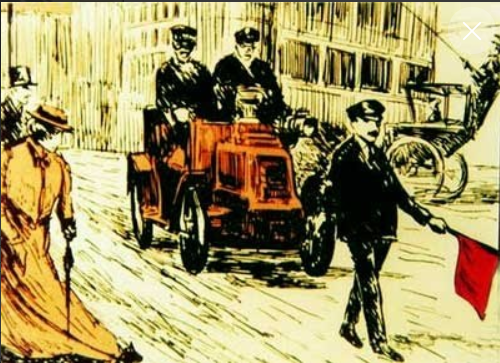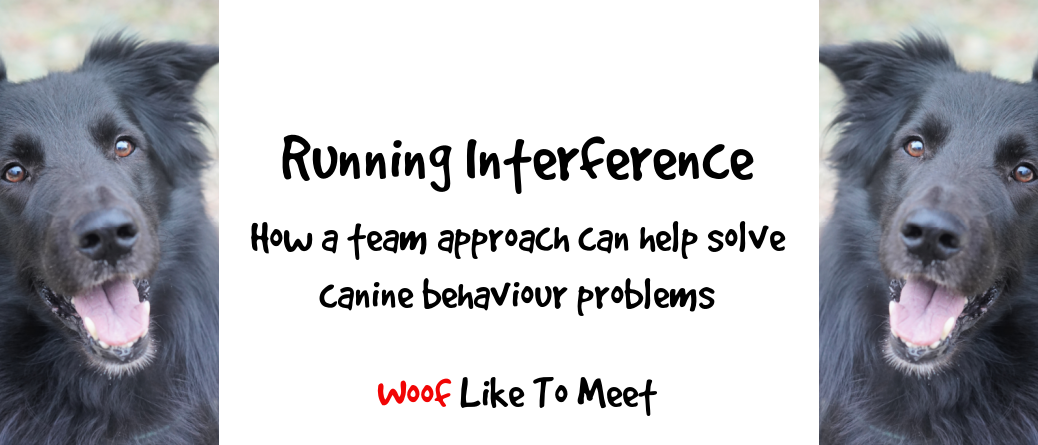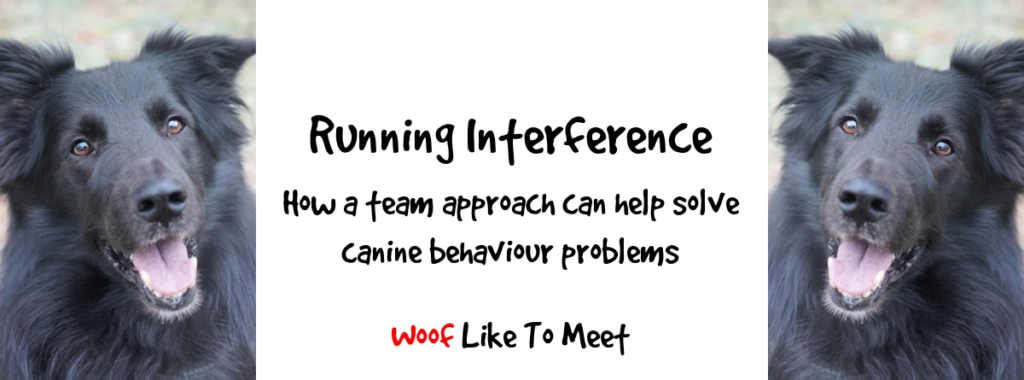Run interference (phrase):
American football: move in such a way as to cause interference
Informal: intervene on someone’s behalf, typically so as to protect them from distraction or annoyance.
One of the toughest stages of training can be proofing, where you put your training to the test. You know the score: you’ve done the groundwork and the drills. You know it’s important to gradually reintroduce your dog to the situation that caused trouble in carefully planned and managed steps.
And then… Life gets in the way.
Let’s take some really common problem behaviours and look at where they can run into teething troubles.
1. You’ve been working with your dog to stop them barking at people who arrive at the property.
2. You’ve been working with your dog to stop them jumping up on guests or on people out on walks.
3. You’ve been working really hard on your dog’s recall.
4. You’ve been working to stop your dog chasing _______________ (fill in the blank!).
5. You’ve been working on loose leash walking skills with your 50kg dog who you’ve switched to a harness after years of trying to control him with prong collars and shock collars, but you’re not confident enough yet to take him out in places he might lunge.
6. You’ve been working hard to help your dog cope in the vet surgery but they still get a bit overwhelmed by the noise and the other animals.
7. You’ve been working with your reactive dog to stop them lunging and barking at other dogs.
8. You’re rehabilitating a dog with serious aggression issues.
We can all find our best laid plans going massively astray the first time something goes wrong and our dog resorts to their previous problem behaviour.
You know how it goes. You’ve spent 6 weeks teaching them a new behaviour, controlling and managing the situation so they don’t get to practise their old behaviour. You think you’ve got it cracked when BAM, right out of the blue, your worst nightmare rears its ugly head and your dog goes right back to jumping, barking, chasing, ignoring you, pulling on the lea, lunging or fence fighting.
What you need is someone to run interference for you! Someone to take out all the people who threaten to derail you. Someone who can block any distractions and stop them so that you can get on with what you’re doing.
None of you are old enough to remember the days when self-propelling machines needed men with flags to walk in front of you, I’m sure. You have probably heard of these apocryphal tales, however. What you need is a red-flag-waving person to help you out.

Having a team-mate to run interference when you’re training your dog can be so helpful. This is someone who’s read the game plan and knows your aims. They know how you intend to carry it out. They know your plays and your purpose. They know you’re trying to stop your whirling dervish pointer from headbutting everyone they see when they’re running off lead. They know you’re trying to turn your whistle training into rock solid recall. And this is as true for serious misdemeanors as it is for the things most of us just try to cope with: serious fearfulness, reactivity or aggression when out in public.
The purpose of this team-mate on the pitch is to clear your path and help manage the environment so you can reach your goal. They’re going to work with you in the same way in real life too. They’re going to stop any potential obstacle derailing your progress so that you can reach your dream goal, be that the dog who keeps all four feet on the ground or the dog who can cope with off-lead dogs romping around without feeling the need to tear their face off.
Let’s take each scenario and see how a team player might help you out.
The alert barker
You may well be implementing the plan from the previous post and your dog may be coping admirably with things that pass by or make noise outside the house, be they tractors, pedestrians or neighbourhood dogs. But what happens when those threats stop outside and ring the bell? Under normal circumstances for planned visitors you may well be controlling visitors by putting the dog in another room with a few food toys. What happens though when some random Tuesday lunchtime, a guy stops to ask if you want your roof tiles cleaning or your paving re-laying? If you’ve not yet moved on to pairing up the doorbell or a knock with the good stuff, having someone who can step in and keep playing games with the dog while you go out and deal with the uninvited guest is a good way to deal with it. Either you send them out to deal with the unwelcome and unplanned arrival while you play games, or you go out while they play games, if they know what you’ve been doing. You can keep your dogs at a distance and they can deal with what needs dealing with.
Use your team mate to ring the bell and knock at the door when your dog’s got used to the ‘thank you – retreat – treat’ protocol from last week. A few trials a day and you’ll have a dog who lets you know someone’s at the door, but who stops barking when you ask.
And if you’re home alone or live alone? A Manners Minder or automatic treat dispenser that you’ve introduced your dog to well before the event can be set to a variable rate of spitting treats out. You can go out and your dog can keep getting paid while you’re not there.
Got more than one dog and suspect a war would break out? Separate them with gates and give them all something to keep them busy while you go out to deal with the inconsiderate sod. And then ask your mates to drop around at scheduled times to play knock-a-door-run so that you can practise ‘thank you – retreat – treat’ with your dogs in carefully planned trials so that when a carpet salesman finally drops round, you’ll be all ready for them.
The over-enthusiastic welcome committee
For dogs who jump up in the house, having a team mate who can welcome guests in while you keep control of the dog to stop them practising is really useful in those early days. Your team mate should be able to explain to your guests that they’re not to give the dog any attention for jumping, but if the dog does a shoulder touch, a hand touch or a high five, then they can say ‘hi!’
While you make sure your dog is able to cope with the drama of new people, your team mate can make sure the new people are able to cope with the excitement of seeing a dog. A spare pair of eyes to stop your guests saying ‘oh good boy! hi!’ and accidentally reinforcing the jumping up won’t go amiss. I find that where things go awry, it’s when we’re overwhelmed, trying to look after our own dog, family and home and we’re not able to adequately manage all the complex pieces. Having someone who can take the dog to another room, play with them a little while you sort everything out and then bring the dog out when energies are lower is another way a team mate can really help you out.
And if you’ve no-one to run interference? Put the dog away with treats until energies have calmed down so that you don’t risk your guests inadvertently reinforcing your dog for jumping all over them.
Proofing your recall
You know the drill. You’ve worked on recall in your home, in the garden, in empty supermarket car parks, in closed fields and with a dropped long lead on quiet, clear walks. You’re gearing yourself up for the real tests when you take your dog to your favourite place, they race off before you and by the time you get round the corner, they’re frolicking with harassing a flock of sheep. Having someone who can go out five minutes before you on your exact walk and then send you a message with an all-clear is really helpful. It also gives you time to put your dog back on the lead should something happen.
Last week, I was working with a young gun-dog who has been charging up to people on walks and had knocked one of them over by jumping all over them. If there had just been someone running interference beforehand who could have been five minutes ahead and said ‘there’s people coming!’, the guardian could have put the dog on the lead way before the dog saw the wildly exciting new friends that he just had to jump on. The trouble was that the dog’s recall was great in most circumstances, but as soon as he saw anyone out on a walk, his recall failed completely. A team mate would definitely help with control and management here.
The diehard chaser
Most of the pedigree and mix-breed dogs in Western countries have been bred to chase to some degree, with the exception of a handful of lapdogs and livestock guardian breeds. From sight and scent hounds to gundogs, cattle dogs, herding dogs to terriers and bull terriers, chase behaviours have been selected for over many generations. This can be really tough if you’re proofing a recall or even if you’re walking a large dog on a lead. I still remember the time four dogs dragged me on my arse through a cowfield…
Having someone to go on ahead and let you know if there are deer, boar, livestock, ducks or wild-roaming joggers, hunters or cyclists can be a great way to make sure you’re not exposed to any unpleasant surprises and trying to live down a ‘Fenton!’ moment while your labrador rampages through the park chasing deer and heavily reinforcing themselves in the process.
The partially reformed lunger
Maybe you read my post about retractable leads a few weeks back and you’ve decided harnesses are the way forward. You’ve got yourself a great new lead, a solid harness and you’re weaning yourself off using a choke, shock or prong collar because you know it’s bad for your dog and it’s probably not even controlling them very much any more if they’re dyed-in-the-wool pullers. Maybe you weigh 60kg and you’re walking a dog who’s only just a little less than you. Perhaps you’ve got two smaller dogs who add up to some hefty tension.
Having a team mate to walk with you is ideal. Pulling can be socially contagious – it can be a bit of a competition to be the husky at the front. And it can be hard to walk two or more dogs and do some real training with both of them. It’s almost as bad if you’ve got a great dog who knows the ropes and one who needs a bit of work. It’s nigh on impossible to train two or more dogs simultaneously so if you need some one-to-one time, a friend is always welcome.
Maybe you’ve done loads of work and they’re almost perfect except they lose their mind on one tiny but essential part of the walk… having a friend to help with another lead is so useful. I know there have been times at the shelter where we’ve got a dog who’s mostly great but who struggles to get out of the shelter grounds because it’s stressful. If you’re trying to manage 45kg of German Shepherd, having a friend to help you on the tough bit means you can put down all your aversive tools which weren’t working anyway. Sometimes, it’s just because it’s muddy and slippy that you need a helping hand. It might only be for 100m or so, but if that means you can get rid of the heavy weaponry, then it’s well worth it.
The not-quite-ready-for-the-vets dog
Maybe you’ve got a dog who you’ve been working so hard to desensitise to the vets, but that heady combination of other dogs, cats, smells, vets, chemicals, barking, squealing, grabby hands and long waits in tiny waiting rooms is likely to set them back six months in progress, having a team mate to run interference is just the ticket. You can stay in the car and do nice stuff with the dog. They can be your substitute in the surgery until your time is ready, and then can act as a great team mate running interference would do – keep their eye out for the old lady who really doesn’t have a good grip on her poodle – avert the very large mastiff-with-attitude standing in the corner and make sure you can get in and out without drama. Not only that, they can help you in the surgery so you can talk to the vet, help manipulate the dog and keep running counter-conditioning while you get the vital information and have grown-up conversations. Perhaps your vets take the dog from you… the same thing is true. Having a friend to run interference can be a dream way of getting into the surgery without subjecting your dog to the miscreants hanging around in there. Your team mate is your wing-person, helping you navigate the complex obstacle course with a cool head. By the end, all they might be doing is humming Mission Impossible music with your dog who had no idea what the bodyguard was for, but if it stops you having a bad experience in a delicate and fragile stage of your progress, all well and good.
The almost-reformed reactive rover
So you’ve been working through a programme to help your dog cope with reactivity. You’re just about ready to go and spend your first five minutes proofing it in the toughest conditions: outside the dog park or at the cani-cross rendezvous site. It’s Murphy’s law that someone won’t have control of their overly-social Donald Trump of a dog who races over to subject your girl to a bit of light humping and who sets you back to square one in your training. A team mate can either take your dog and walk away while you occupy the offender, or you can walk off leaving them to do the same. Given that you will need to practise in some challenging conditions before you are truly able to say your dog can cope, knowing you can do so without derailing everything you’ve done is a true gift.
Truly effective rehabilitation
When you’re working with a dog who has bitten a member of the public or another dog, even if it was only a nip or a grab, it can be nerve-wracking to take them out in public. So what are you supposed to do? Keep them in forever? One of the hardest things to do is build up really positive experiences and make sure you’re keeping people and their animals safe. A team mate who goes out before you, runs interference with stray dogs and wandering humans, who acts as your spotter and your guide, who can help you work through the awkward bits, well, they’re invaluable. Of course, you may have had to use them as a stooge too at the beginning, so that your dog gets used to them. But if your dog is such a risk that they’d bite any person they see, then you definitely, definitely will need some friends who can act as a stooge so that you can control what they do, how they move and where they go. It’s no use trying to rehab your dog using unsuspecting members of the public. That’s a huge liability.
You may, of course, have partners, parents, adult children, neighbours or friends who are willing to help out. If not, don’t worry. There’s an army of professionals who can help you, from dog walkers and trainers to behaviour consultants. I can’t tell you how useful it is to pay a dog walker a tenner to let you know their schedule so you can follow them around for half an hour every day and desensitise your dog in a low risk situation. There are many professionals who might help out if you bung them a bit of cash. Maybe you know exactly what you need to do. Maybe you’ve been working with a great behaviour consultant and you just need some people to practise on who don’t charge quite so much.
In any case, find yourself a team mate. They won’t just inspire you and challenge you, but they’ll also enable you to bridge the gap between ‘nearly!’ and ‘touchdown!’


